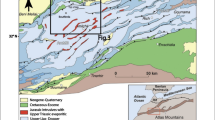Abstract
The principles and the algorithm of order classification of river watershed divides are outlined. It is shown that a formal application of any available order classification procedures for river watershed divides is not theoretically grounded as well as being impractical, because the physical mechanisms for formation of watershed divide network are different from those operating in the river network. We have formulated the basic principle of determining the watershed divides order on the basis of a serial sequence of sections constituting the travel path of an arbitrary water drop from the watershed divide to the outlet section of the basin. It is suggested that the order N should be assigned to the section of the watershed divide belonging to the full divide line of the N-order basin only if the travel path from it to the N-order stream is “full” in the topological sense, i.e. includes sections of all orders, from 1 to N. Also, we present a variant of determining the order on the basis of so-called higher-order triplets, incomplete sequences of sections of three neighboring orders along the travel path, with the higher of them determining the watershed divide order. The use of triplets is a subjective procedure of generalization that eliminates the influence of recent random erosional incisions on the forms of stable high-order watersheds. We outline the variants of the technique for identifying the network of watershed divides and calculating their orders, based on processing the digital elevation models (DEM) through the use of standard GIS ArcMap tools. Results are obtained in the form of a correlated classification of river and watershed networks which are rationally interpreted and hold promise for investigating the structure, functioning and evolution of river systems. The study revealed the existence of formation “cores” of river systems, i.e. regions within which the system reaches a higher stream order and which are bounded by watersheds of the same order.
Similar content being viewed by others
References
Horton, R.E, Erosional Development of Streams and Their Drainage Basins: Hydrophysical Approach to Quantitative Morphology, Geol. Soc. Amer. Bull., 1945, no. 56, pp. 275–370.
Gartsman, B.I., Bugayets, N.D., Tegai, S.M., and Krasnopeyev, S.M., Analysis of the Structure of River Systems and the Prospects for Modeling Hydrological Processes, Geogr. Nat. Resour., 2008, vol. 29, issue 2, pp. 116–123.
Rodríguez-Iturbe, I. and Rinaldo, A., Fractal River Basins: Chance and Self-Organization, Cambrige: Cambrige University Press, 1997.
Gartsman, B.I., Analysis of Geomorphological Conditions for Primary Streams Formation Using Digital Elevation Models, Geogr. Nat. Resour., 2013, vol. 34, issue 1, pp. 69–78.
Gartzman, B.I., Hydrographic and Landscape Description of a River Basin based on GIS- and Geographic Data, Russ. Meteorol. Hydrol., 2014, vol. 39, issue 6, pp. 407–415.
Gartsman, B.I. and Galanin, A.A., Structural-Hydrographic and Morphometric Analysis of River Systems: Theoretical Aspects, Geogr. Nat. Resour., 2011, vol. 32, issue 3, pp. 226–234.
Gartsman, B.I. and Shekman, E.A., Potential of River Network Modeling Based on GIS Technologies and Digital Elevation Model, Russ. Meteorol. Hydrol., 2016, vol. 41, issue 1, pp. 63–71.
Korytny, L.M., The Basin Concept in Nature Management, Irkutsk: Institute of Geography SBRAS, 2001 [in Russian].
Ananiev, G.S., Analysis of Interfluves for Morphostructural and Exploration Purposes, Vestn. Mosk. Univ., Ser. 5, Geografiya, 1984, no. 3, pp. 56–62 [in Russian].
Chernova, I.Yu., Nugmanov, I.I. and Dautov, A.N., Application of GIS Analytic Functions for Improvement and Development of the Structural Morphological Methods of the Neotectonics Studies, Geoinformatika, 2010, no. 4, pp. 9–22 [in Russian].
Shuttle Radar Topography Mission (SRTM). URL: http://earthexplorer.usgs.gov/; http://gis-lab.info/qa/srtm.html (Accessed March 4, 2015).
Gubareva, T.S., Classification of River Basins and Hydrological Regionalization (as exemplified by Japan), Geogr. Nat. Resour., 2012, vol. 33, issue 1, pp. 74–82.
Bugaets, A., Gartsman, B.and Bugaets, N., River Network and Watershed Morphology Analysis With Potential Implications Towards Basin Classification, Geophysical Research Abstracts, 2013, vol.
URL: http://meetingorganizer.copernicus.org/EGU2013/EGU2013-1736.pdf (Accessed September 2, 2015).
Karasev, M.S., Gartsman, B.I. and Tashchi, S.M., Spatiotemporal Regularities of River Channel Morphogenesis in Mountain Systems of the Monsoon Zone, Geogr. Prir. Resur., 2000, no. 1, pp. 106–120 [in Russian].
Author information
Authors and Affiliations
Corresponding author
Additional information
Original Russian Text © B.I. Gartsman, E.A. Shekman, K.T. Lee, 2016, published in Geografiya i Prirodnye Resursy, 2016, Vol. 37, No. 4, pp. 164-173.
Rights and permissions
About this article
Cite this article
Gartsman, B.I., Shekman, E.A. & Lee, K.T. Order classification of river watershed divides based on processing digital elevation models. Geogr. Nat. Resour. 37, 362–370 (2016). https://doi.org/10.1134/S1875372816040119
Received:
Published:
Issue Date:
DOI: https://doi.org/10.1134/S1875372816040119




